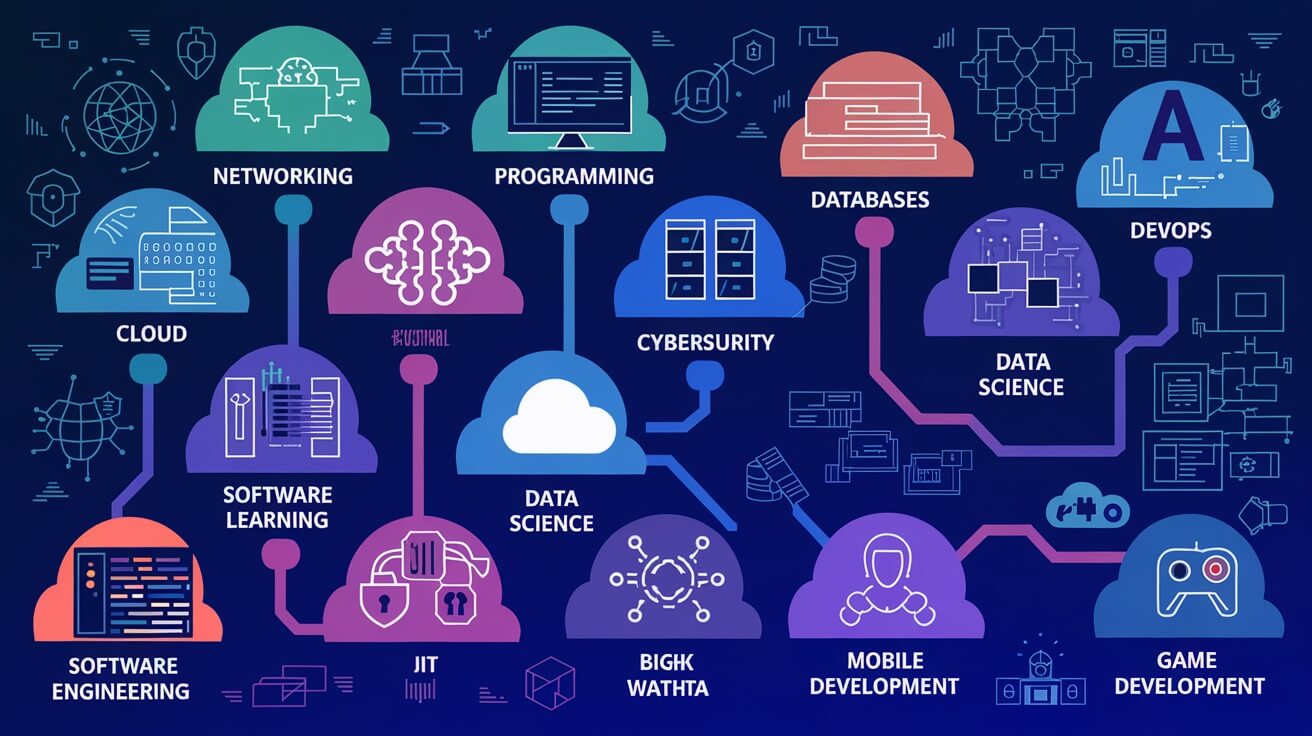
A Comprehensive Guide to Primary and Secondary Technical Domain Skills
Introduction
In the rapidly advancing field of technology, knowing which skills to focus on can feel overwhelming. With so many technical abilities, how do you determine what's essential and what adds value? This guide dives into two main categories: primary and secondary technical skills. Primary skills are core abilities directly required for a job. In contrast, secondary skills are supportive, making you more versatile and effective.
Understanding this distinction is essential to excelling in a tech career or hiring for tech positions. This article will explore primary and secondary technical skills, why they matter, and how to develop and balance them to enhance career growth. Let's break down these categories and provide practical strategies to help you focus your efforts for maximum impact.

What Are Technical Domain Skills?
Technical domain skills are the knowledge and abilities to perform specific tasks in technology-focused roles. These skills vary depending on the industry but typically include programming, data analysis, network security, and database management. Each domain, IT, software development, or cybersecurity, requires unique technical skills.
The Role of Technical Skills in Career Development
In the tech industry, technical skills are more than just a checkbox on a job description—they're the core abilities that define your ability to perform well in a role. These skills signal to employers that you can manage essential responsibilities and be prepared to bring meaningful contributions to a team. For instance, a data analyst's proficiency with data visualization or a software developer's knowledge of coding languages showcases their capability to meet the demands of their role.
The nature of technical skills means that they are constantly evolving. As new technologies emerge, they shape industry needs, creating a demand for updated skills. Today, skills in fields like artificial intelligence, cloud computing, and cybersecurity are increasingly essential, and keeping up with these shifts is key for anyone aiming to grow in tech.
This continuous learning aspect makes tech a dynamic career path, where staying current with skills can lead to more opportunities and career advancement.
Developing a solid technical skills foundation also provides professionals the flexibility to transition into new roles or take on challenging projects. Employers highly value this adaptability, especially in cross-functional teams where technical knowledge must integrate with other areas. In this way, building and maintaining technical skills supports immediate job performance and opens up future pathways, making it an essential part of long-term technological career development.

1. Primary Technical Skills
Primary technical skills form the foundation of any technology-based role. These core skills, often non-negotiable in job descriptions, are essential for performing the basic functions of a job.
Overview and Importance of Primary Technical Skills
Primary skills are usually the main qualifications employers look for in candidates. They're the skills central to your technical ability and allow you to perform essential tasks. For instance, a software developer needs knowledge of programming languages like Python or Java. At the same time, a network engineer must understand network protocols and configurations.
Examples of Primary Technical Skills Across Domains
Software Development:
Mastery of programming languages like Python and JavaScript is fundamental for software developers. These skills enable developers to build applications, create algorithms, and work with data structures, essential components in designing efficient, high-performance software.
Data Science:
Data science requires a solid foundation in data analysis, machine learning, and statistical methods. Skills in SQL for database management are also crucial, as they allow data scientists to manipulate and retrieve large datasets, identify trends, and make data-driven predictions.
Networking:
Networking: In networking, primary skills include a strong understanding of network configuration and security protocols. Proficiency with TCP/IP protocols is also vital. These protocols, the backbone of Internet communication, enable network professionals to establish and maintain reliable connections across various networks, ensuring data flows efficiently and securely.
Recent Trends in Primary Technical Skills
The demand for primary technical skills changes as technology advances. For example, with the rise of AI, cloud computing, and cybersecurity, skills in cloud platforms like AWS, machine learning frameworks, and security protocols are increasingly sought after.
Artificial Intelligence (AI):
For instance, AI is used in healthcare for disease diagnosis and treatment planning, finance for fraud detection, and retail for personalized marketing. Artificial Intelligence (AI): Proficiency in AI and machine learning frameworks is now highly sought after. Skills in programming languages i.e. Python and experience in machine learning libraries like TensorFlow and PyTorch are essential for developing intelligent systems. According to Coursera, AI and machine learning specialists are among the fastest-growing job roles, reflecting the significant demand for these skills.
Cloud Computing:
As businesses migrate to cloud platforms, expertise in services like Amazon Web Services (AWS), Microsoft Azure, and Google Cloud Platform (GCP) is increasingly important. Understanding cloud architecture, deployment, and management enables professionals to build scalable and efficient systems. Pluralsight highlights that cloud services are critical for most companies, emphasizing the need for skills in this area.
Cybersecurity:
With the rise in cyber threats, knowledge of security protocols and practices is crucial. Skills in risk mitigation, threat analysis, and familiarity with compliance regulations are vital for protecting organizational assets. Coursera notes that IT security positions require familiarity with physical, network, and software security, data encryption, and ethical hacking.
2. Secondary Technical Skills
Secondary technical skills are supportive abilities that enhance your primary skills, contributing to improved job performance. While these skills may not always be the primary qualifications listed for a role, they make you a more versatile professional who can tackle diverse tasks and collaborate seamlessly with others.
For instance, effective communication, documentation, and troubleshooting are secondary skills that help bridge gaps within teams and ensure smoother workflows. Strong secondary skills allow you to adapt quickly to different projects and work environments, making you an asset to any team.
Overview and Value of Secondary Technical Skills in the Workforce
While primary skills enable you to perform core tasks, secondary skills support those tasks, helping you to be more efficient and adaptable. They often involve support functions, troubleshooting, or collaboration, which can improve productivity and teamwork. In many cases, secondary skills are transferable across jobs, adding versatility to your professional profile.
Examples of Secondary Technical Skills Across Domains
-
Testing and Debugging: Useful for identifying and resolving issues in code, especially valuable for software developers.
-
Documentation and Reporting: These are essential for communicating complex processes or project details to team members or clients, and they are commonly needed in roles like project management or technical writing.
-
Technical Support and Maintenance: Vital in positions where system functionality and uptime are priorities, such as IT support.
Evolution of Secondary Skills in Different Industries
As tech roles become more integrated with business functions, secondary skills like documentation, client communication, and project management have gained significance. Today, companies value professionals with technical skills who can effectively communicate and document their work.
Building and Balancing Primary and Secondary Skills

Both primary and secondary skills are critical to a successful career in technology. However, striking the right balance between them is key to maximizing effectiveness in your role.
How to Develop Each Skill Set
Primary Skills:
Focus on the primary skills central to your field. For example, a data analyst might start by mastering a programming language like Python or becoming proficient in data visualization tools. Online courses, certifications, and hands-on projects can help build these skills.
Secondary Skills:
These can be developed alongside primary skills through practical experience. For instance, you can build documentation skills by creating project reports or sharing insights on technical topics. Communication skills can be honed by collaborating with non-technical teams.
Self-Assessment and Real-world Applications
Self-assessment tools, such as a SWOT analysis (which examines Strengths, Weaknesses, Opportunities, and Threats), can help you identify areas for growth and improvement. This method is beneficial for recognizing how your primary and secondary skills work together. For real-world application, internships and personal projects are excellent ways to apply and refine both skill sets.
Tips for Prioritizing Skill Development
Look at job descriptions within your field to identify which skills are primary and which are secondary. This can help you prioritize your development efforts and tailor your resume to highlight the skills employers seek.
Why Differentiating Skills is Essential for Career Growth
Knowing the difference between primary and secondary skills can enhance your job search and help you target your learning effectively.
Primary and Secondary Skills in Job Descriptions
Job descriptions often distinguish between essential and desirable skills. Primary skills are typically listed as "required," while secondary skills may be categorized as "preferred" or "nice to have." Recognizing this difference can assist you in customizing your applications and getting ready for interviews.
How Employers Use Skill Differentiation in Hiring
Employers look at primary skills to determine whether a candidate can meet the core demands of a role. Secondary skills often signal adaptability and the ability to work in diverse settings. By emphasizing both skills in your application, you can position yourself as a well-rounded candidate who adds value to a team.
Top List of Primary Technical Domain Skills
These core skills are essential for performing specialized tasks in various tech domains:
1. Software Development
-
Programming Languages: Python, JavaScript, Java, C++
-
Data Structures and Algorithms: Sorting, searching, tree structures
-
Version Control: Git, GitHub, Bitbucket
-
Software Development Frameworks: Django, React, Angular
2. Data Science & Analytics
-
Data Analysis: Pandas, NumPy, Excel
-
Machine Learning: TensorFlow, scikit-learn, Keras
-
Statistical Analysis: R, SAS, SPSS
-
Data Visualization: Tableau, Power BI, Matplotlib
3. Networking & Cybersecurity
-
Network Configuration: Cisco, Juniper, TCP/IP protocols
-
Network Security: Firewalls, Intrusion Detection Systems (IDS), Virtual Private Networks (VPNs)
-
Cloud Security: AWS Security, Azure Security, Identity and Access Management (IAM)
-
Cryptography: SSL/TLS, AES, RSA
4. Cloud Computing & Infrastructure
-
Cloud Platforms: AWS, Google Cloud, Microsoft Azure
-
Containerization: Docker, Kubernetes
-
DevOps: CI/CD, Jenkins, Ansible
-
Virtualization: VMware, Hyper-V
5. Database Management
-
Database Systems: MySQL, PostgreSQL, Oracle, MongoDB
-
SQL Proficiency: Joins, indexing, optimization
-
Data Warehousing: ETL processes, data lake, Redshift, BigQuery
-
Database Security: Encryption, access control, backup management
Top List of Secondary Technical Domain Skills
These supplementary skills help enhance efficiency, support collaboration, and improve adaptability within tech roles:
1. Communication & Collaboration
-
Technical Documentation: Writing clear and concise documentation for technical processes
-
Interpersonal Communication: Explaining complex concepts to non-technical team members
-
Team Collaboration Tools: Slack, Microsoft Teams, Zoom
2. Troubleshooting & Problem-Solving
-
Debugging: Identifying and resolving code or system errors
-
System Troubleshooting: Diagnosing and fixing network or infrastructure issues
-
Root Cause Analysis: Analyzing problems to find underlying causes and implement solutions
3. Project Management
-
Agile Methodology: Familiarity with Scrum, Kanban
-
Task Management Tools: Jira, Asana, Trello
-
Time Management: Prioritizing and managing tasks effectively to meet project deadlines
4. User Experience & Interface Design (UI/UX)
-
UI Design Basics: Understanding design principles for user-friendly interfaces
-
User Research: Conducting usability tests and gathering feedback
-
Prototyping Tools: Figma, Sketch, Adobe XD
5. Data Handling & Reporting
-
Data Cleaning and Transformation: Ensuring data quality before analysis
-
Data Visualization: Creating charts and dashboards to communicate insights
-
Reporting Tools: Power BI, Tableau, Google Data Studio
Conclusion:
Grasping the difference between primary and secondary technical skills is essential for anyone building a career in technology. Primary skills enable you to meet a job's core requirements, while secondary skills add versatility, enhancing your overall effectiveness.
Key Takeaways
-
The distinction between primary and secondary skills can steer your learning and growth efforts.
-
Tailoring your resume and interview responses based on this distinction can increase your chances of landing your desired role.
-
Focusing on primary skills first, then gradually building secondary skills, is a balanced approach for long-term career growth.
Evaluating your strengths and areas for improvement allows you to design a focused plan to build primary and secondary skills. This approach improves your professional profile and prepares you for a dynamic and successful career in tech.
Frequently Asked Questions (FAQs)
What are primary and secondary technical skills?
Primary technical skills are core abilities needed to perform essential tasks. In contrast, secondary technical skills support these primary abilities, enhancing productivity and collaboration.
Why is it important to differentiate between primary and secondary skills?
Differentiating helps you prioritize skill development based on job requirements, making aligning your abilities with career goals easier.
How do primary skills differ from secondary skills in IT?
In IT, primary skills include programming or network management, while secondary skills involve documentation and user support.
What are examples of secondary technical skills?
Secondary skills can consist of troubleshooting, project documentation, and cross-functional collaboration.
How can I develop both primary and secondary technical skills?
Focus on primary skills through dedicated learning and projects, and build secondary skills by working on communication, documentation, and teamwork.
Life Skills




